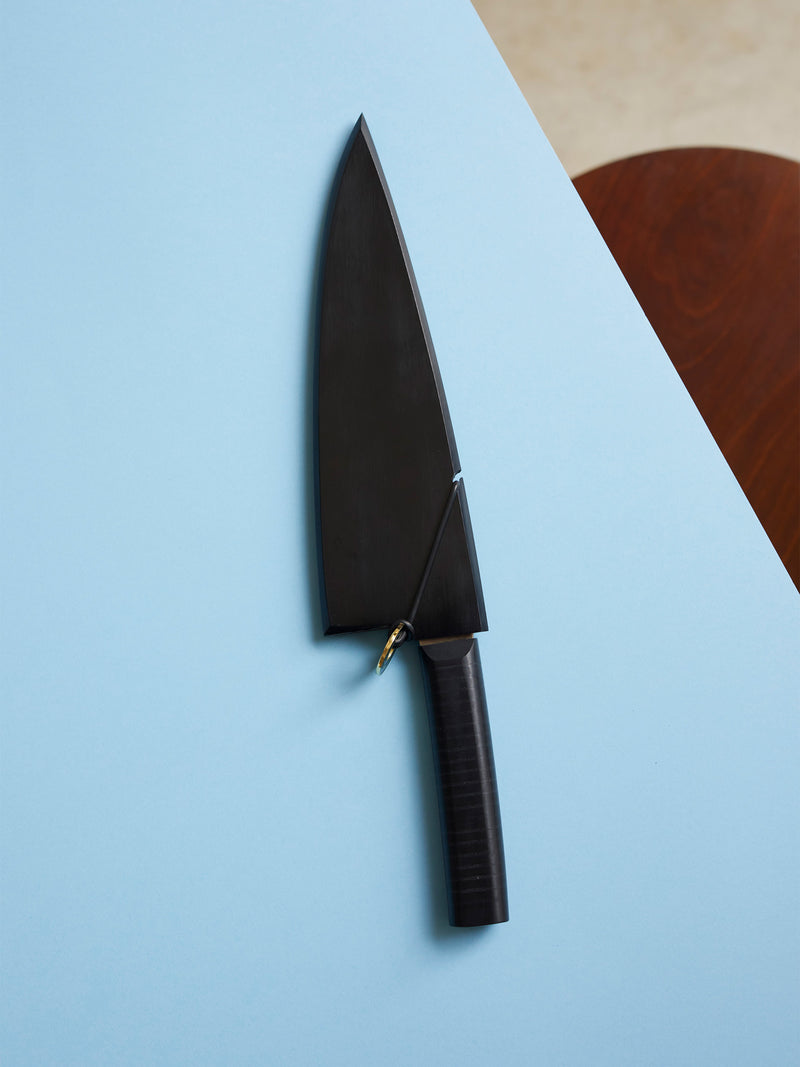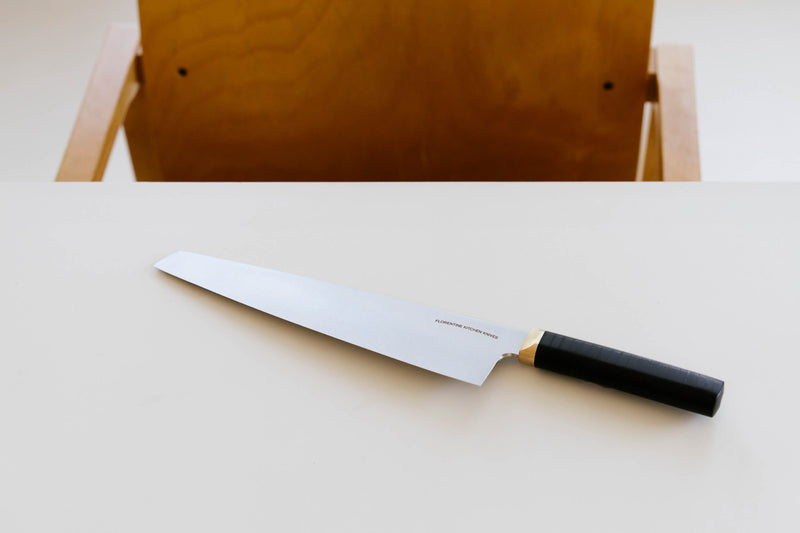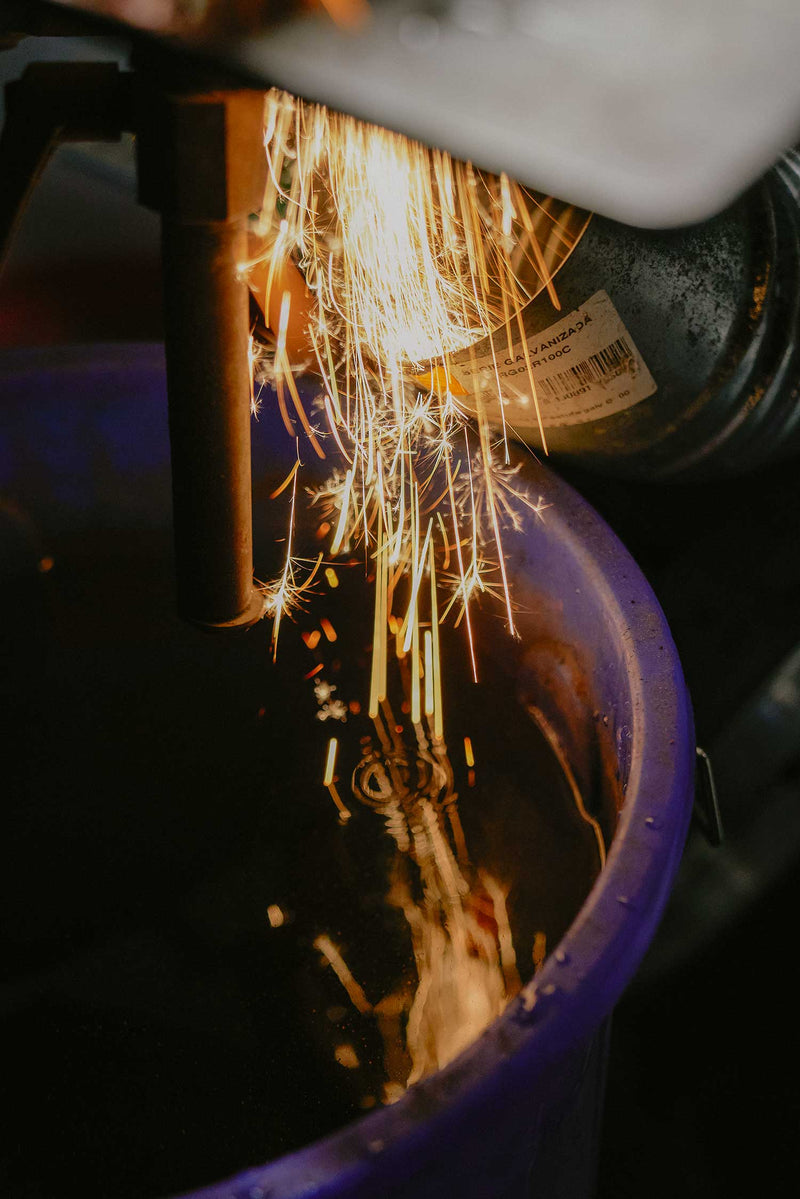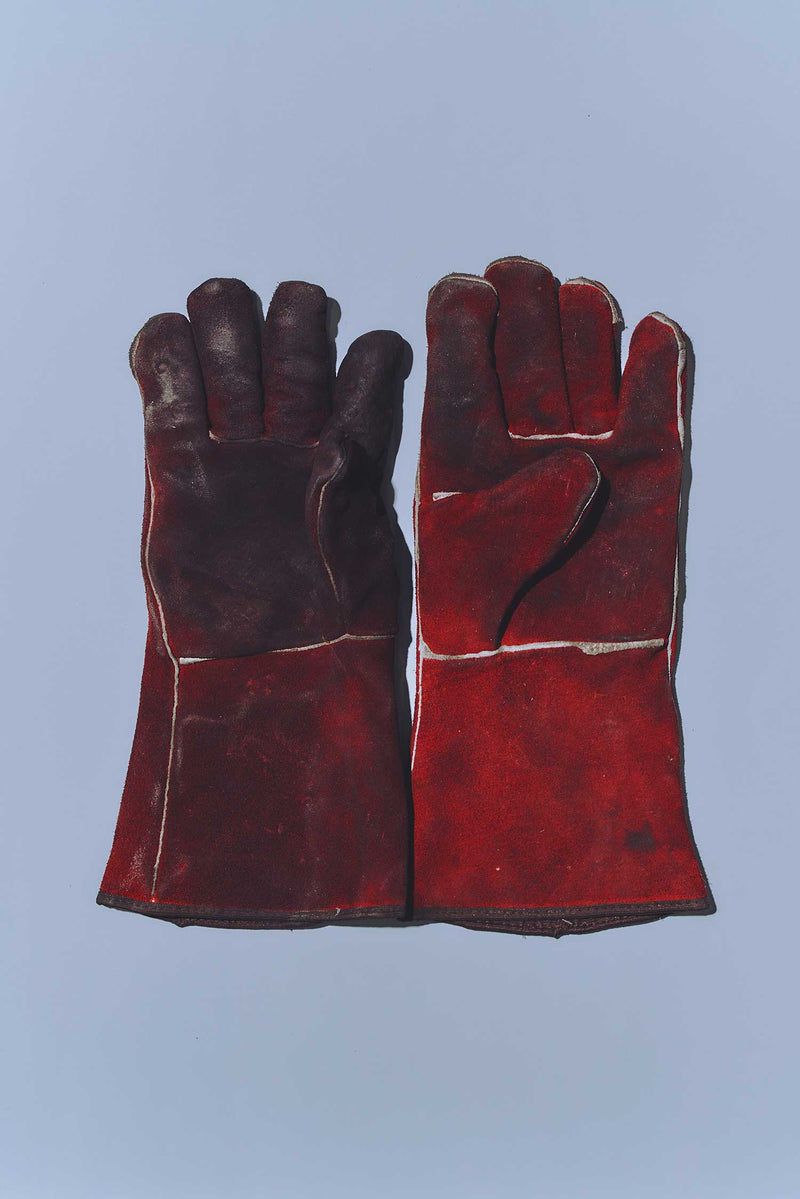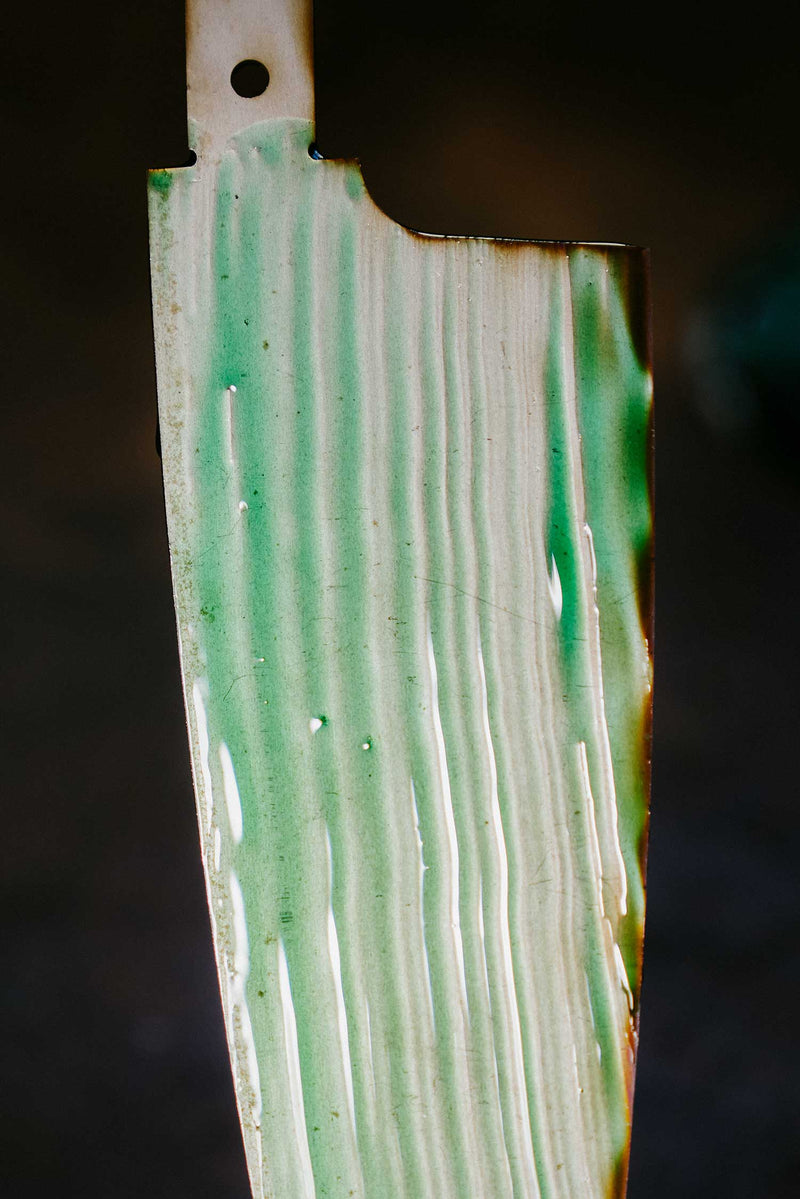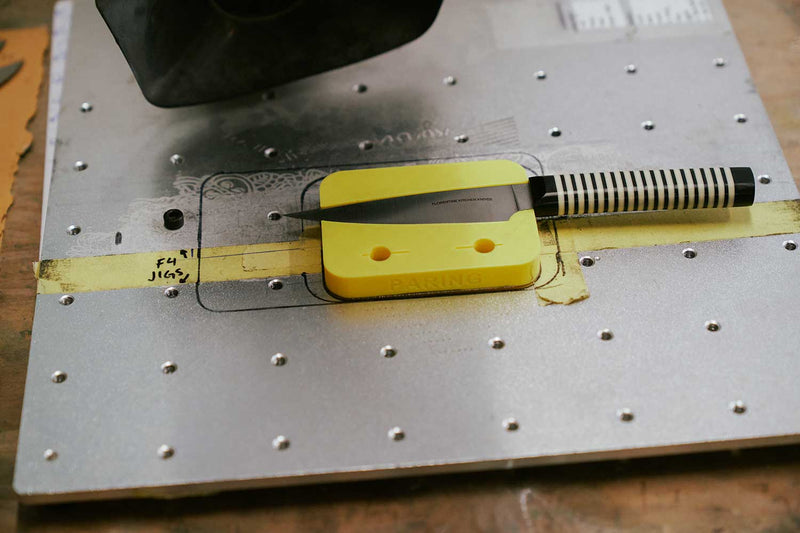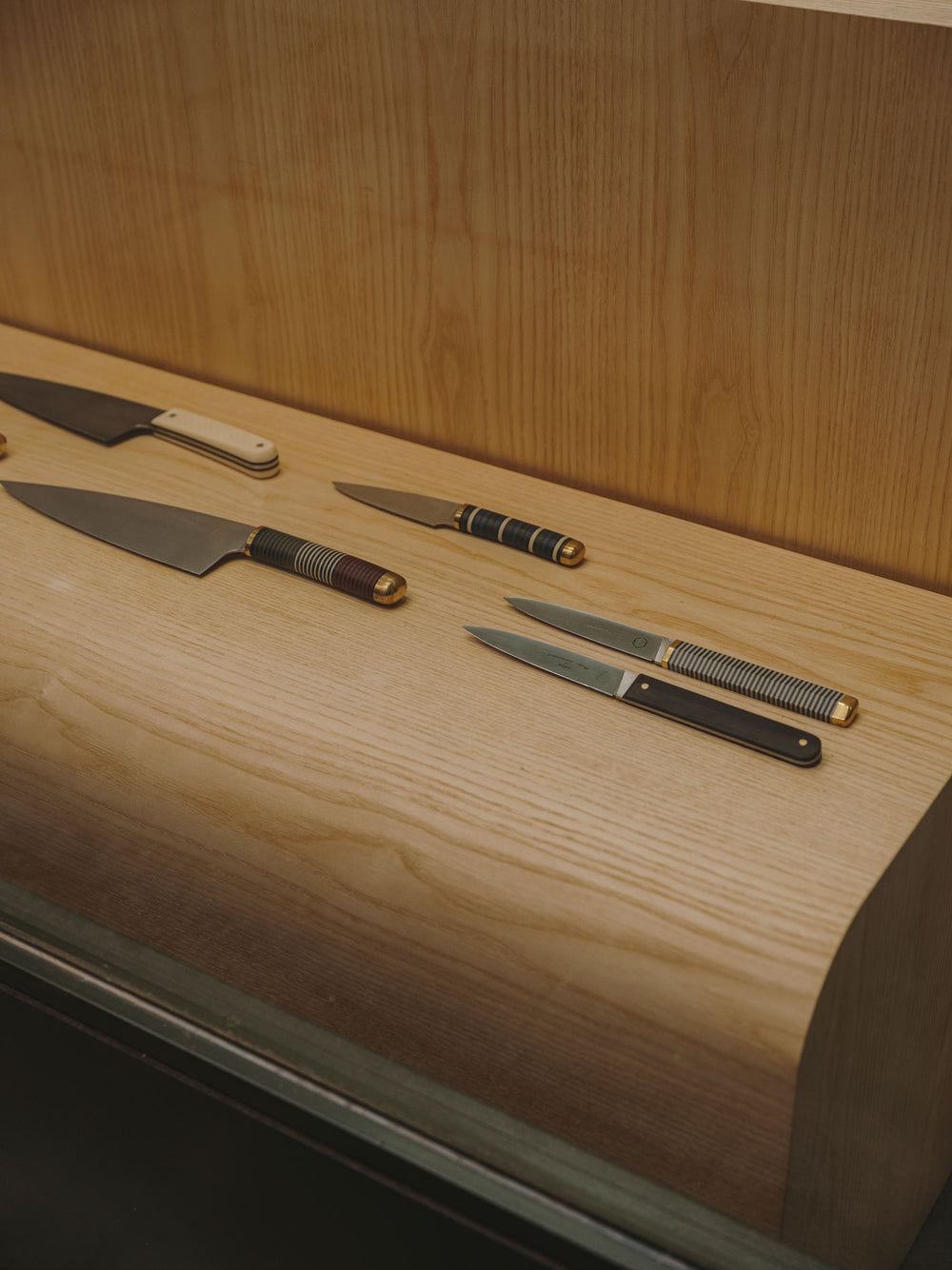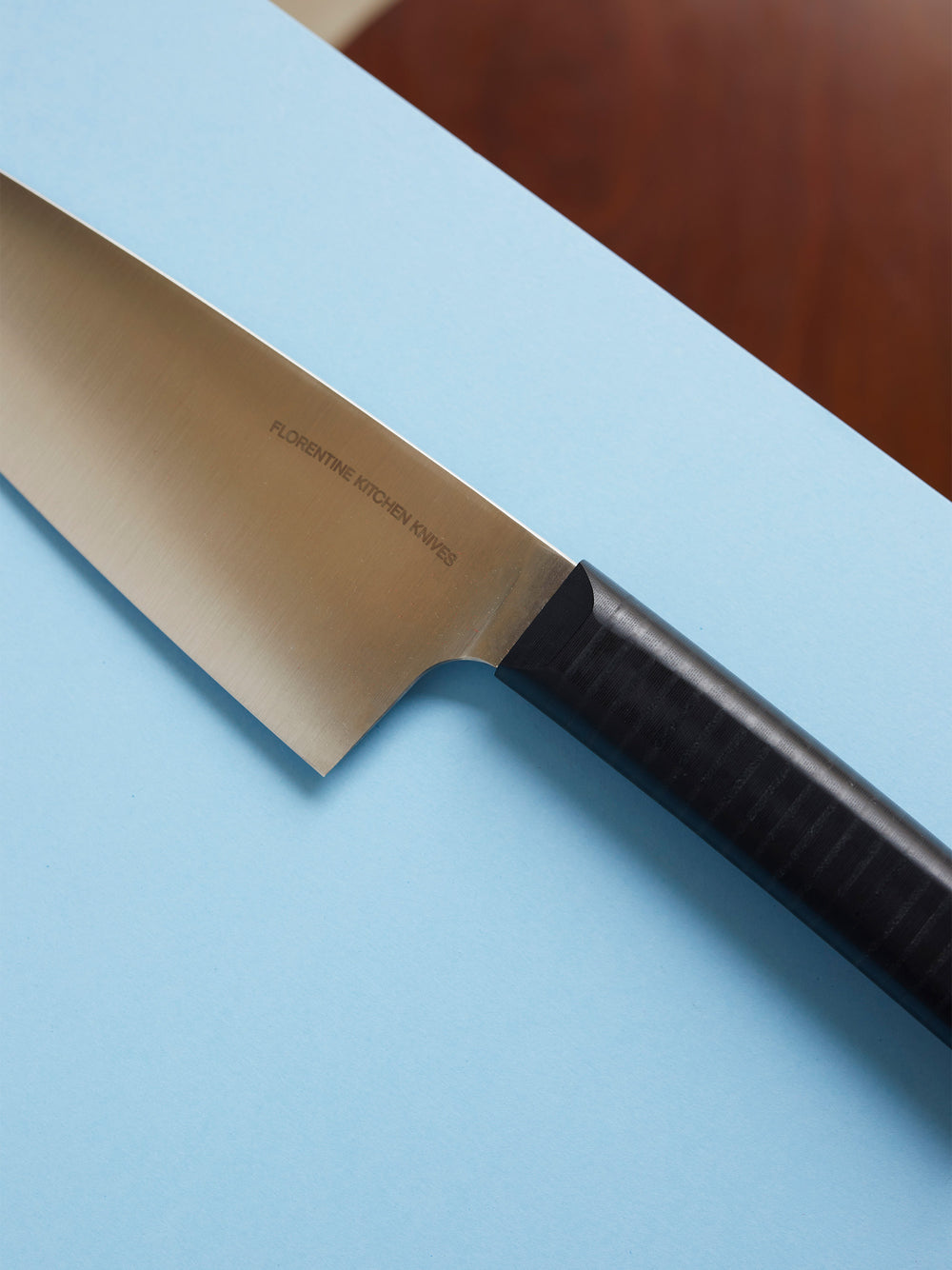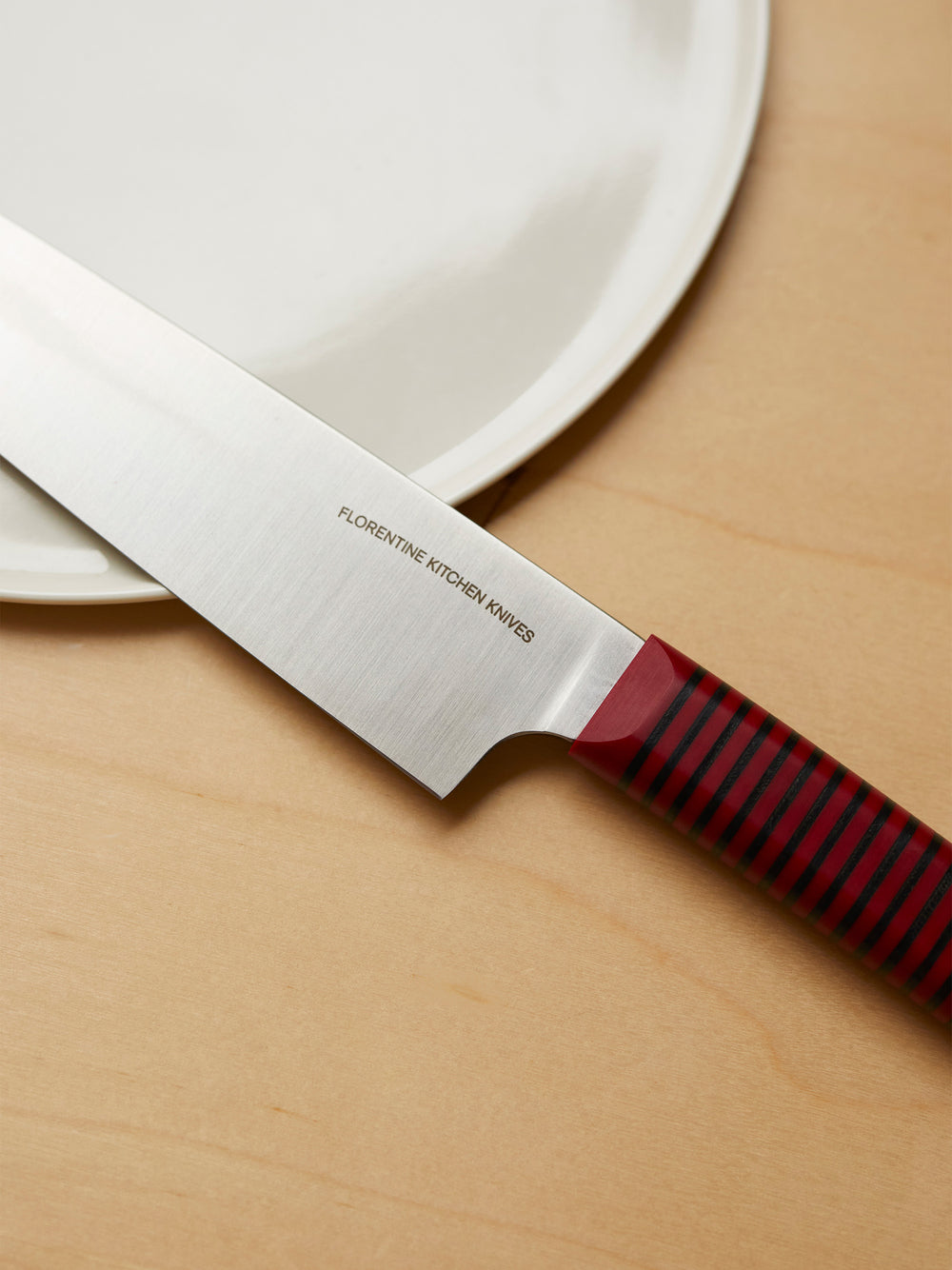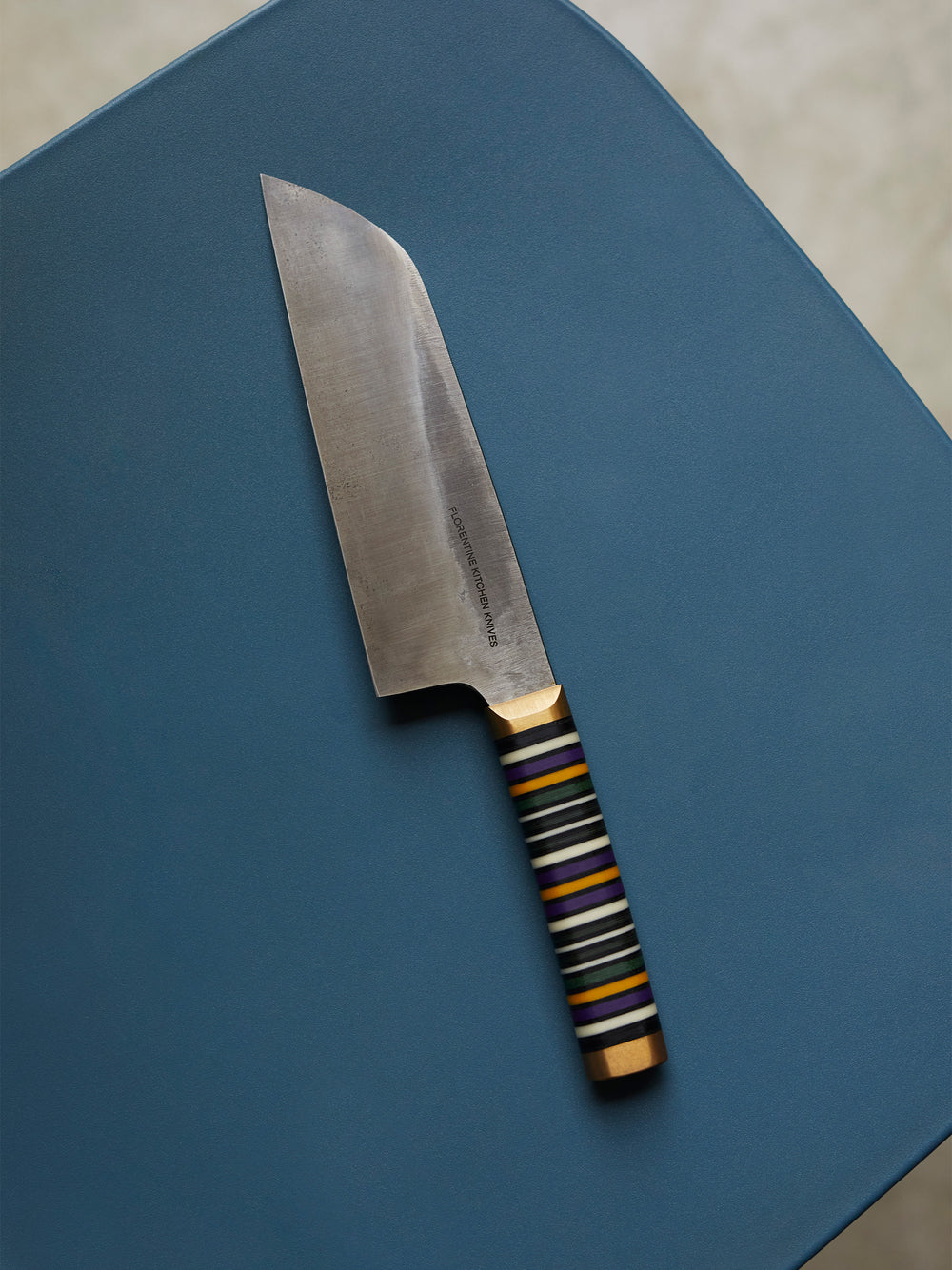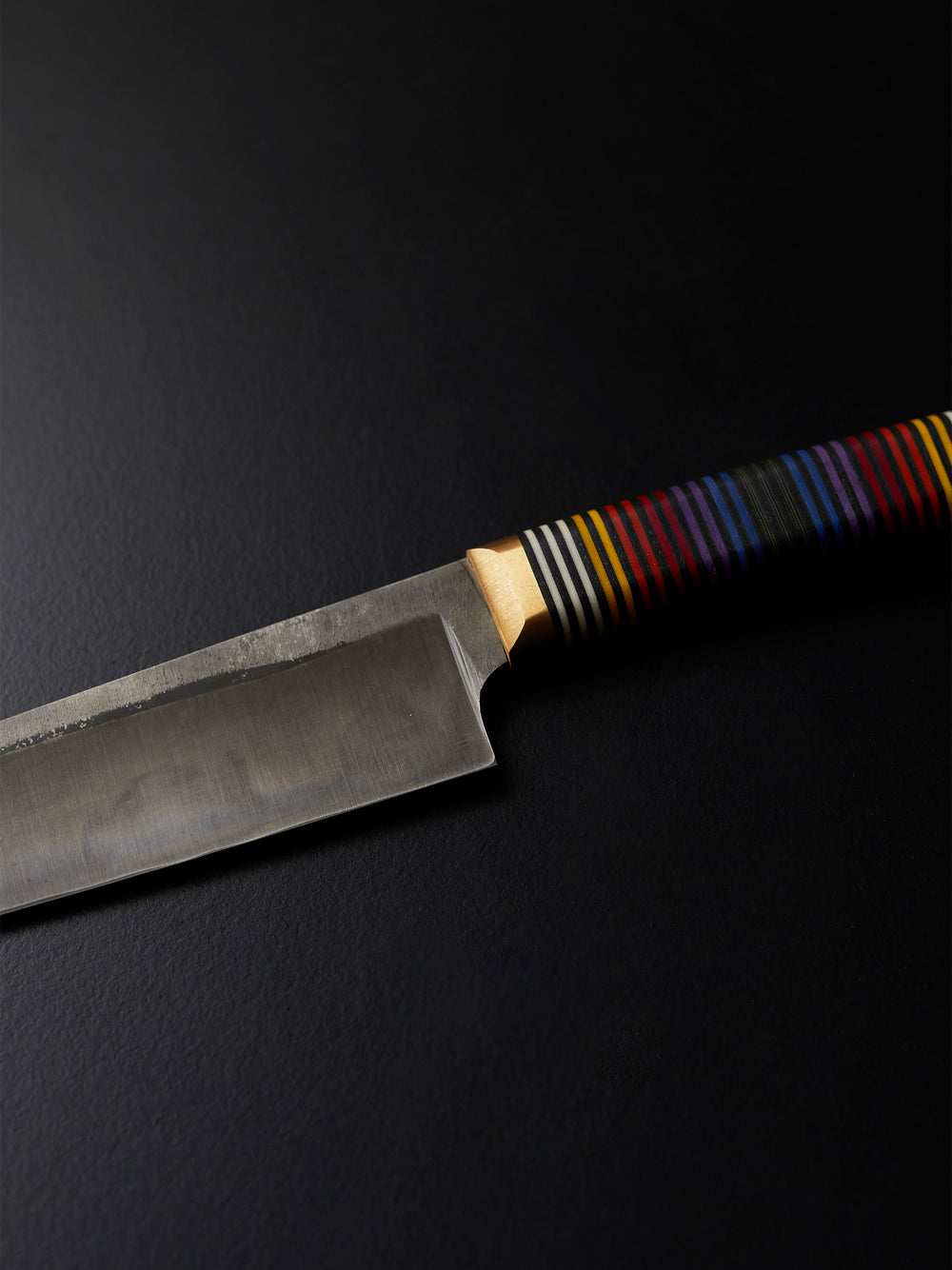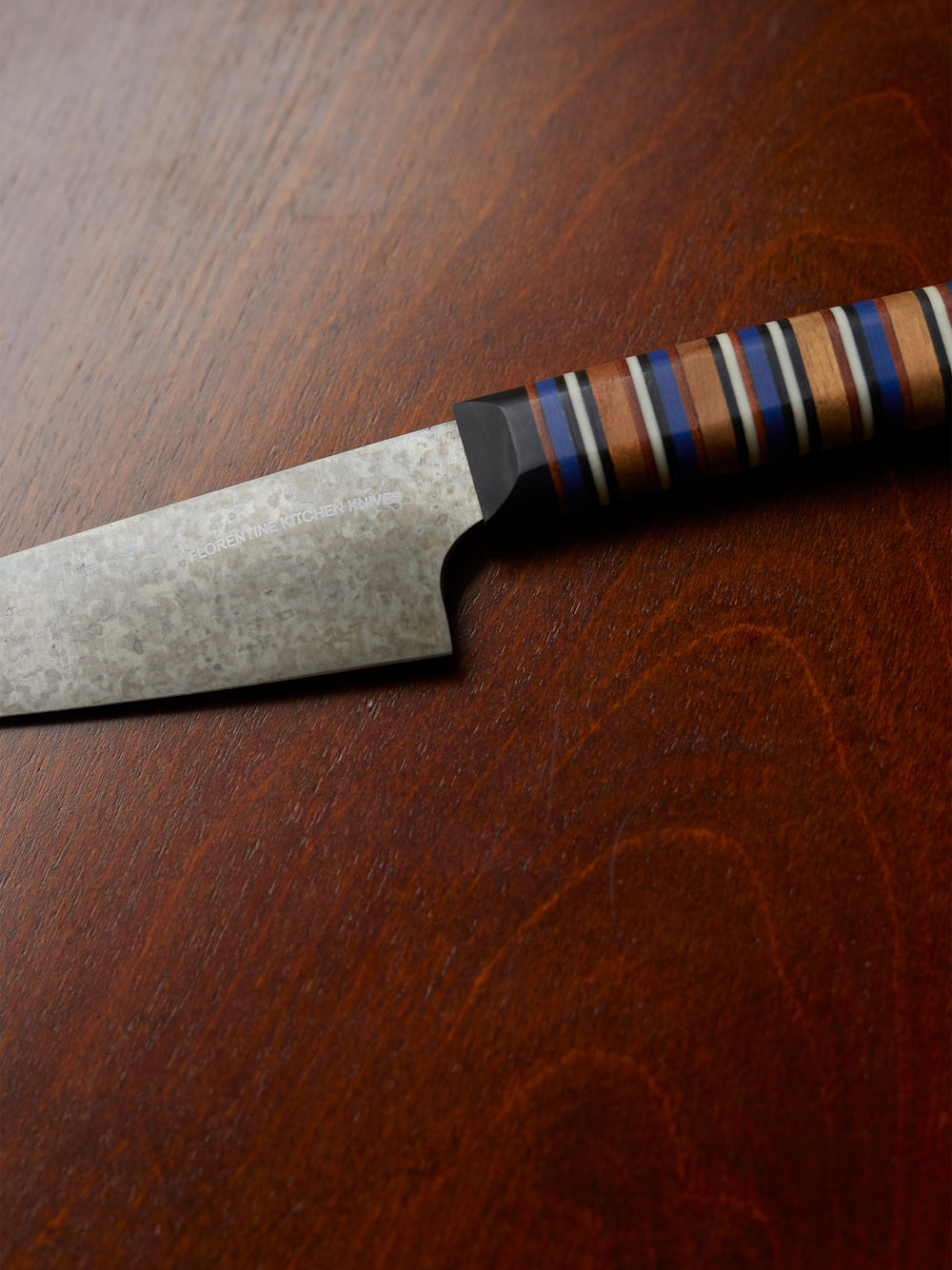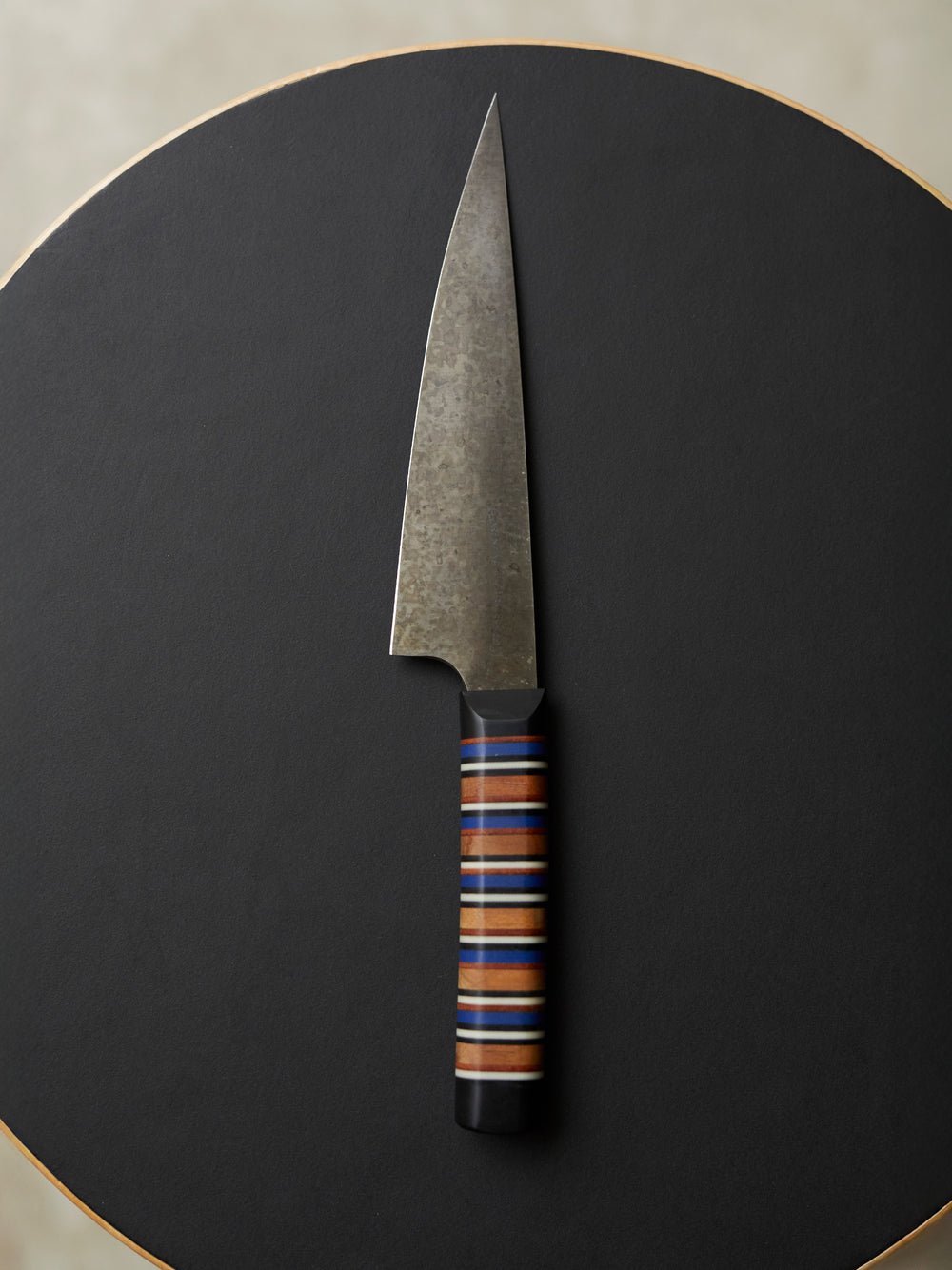Our readily available knives - the Florentine core collection, special editions and one-off creations and collaborations.
Knife guide
Many people tell us they want “a knife for fish, meat and vegetables’’. What they probably mean is that they want a knife that does all the day-to-day work in the kitchen, and usually one they can work with on the cutting board. Our most popular knives - the Chef, Gyuto and Utility - are used for all kinds of chopping, slicing and dicing on the work surface, for most types of produce.

The most versatile and multipurpose kitchen knife. With it’s broad, tapered blade, and at 205mm in length by 57mm tall and 3mm thick, the Chef is the king of all cutting board tasks. Also known as a cook’s knife or a French knife, It is an essential tool for professional chefs and home cooks alike. It features a curved blade profile that facilitates rocking motions for chopping, slicing, and mincing and the height to give you comfortable knuckle clearance on the cutting board.

The most versatile and multipurpose kitchen knife. At 205mm in length, 57mm tall and 3mm thick at the base of the blade is the king of all cutting board tasks. Also known as a cook’s knife or a French knife, It is an essential tool for professional chefs and home cooks alike. It features a curved blade profile that facilitates rocking motions for chopping, slicing, and mincing and the height to give you comfortable knuckle clearance on the cutting board.

A bigger and heavier version of our Chef knife, it features a flatter edge and a different tip, adding to its safety. This model borrows elements from the Japanese Gyuto and from the Large Chopper (or Nakiri in Japanese). With it’s double beveled blade and an edge length of 240mm, 57mm tall and a 3mm steel stock, this is a heavy hitter capable of bigger production. It can also double as a Chef knife and slicer in skilled hands. It is suitable for a wide range of cutting tasks and produces precise, clean cuts.
Perfect for peeling fruit, trimming vegetables, de-veining shrimp, or making intricate cuts, these knives excel at delicate work that requires control and accuracy, whether in your hands or on the cutting board.

A small, versatile kitchen knife with a narrow blade at 120 mm in length. This compact size allows for precise control and manoeuvrability, ideal for delicate tasks such as peeling, trimming and creating decorative garnishes, as well as for simple and short tasks for everyday use.

A versatile medium sized kitchen knife with a 150mm long edge. Smaller and lighter than Chef knives, these are ideal for precision tasks such as trimming, slicing and intricate cutting work, but can also perform some cutting board tasks as well as peeling. This is an excellent service knife, very good for most things, but a master of none.
Cutting board knives which are mainly used for chopping vegetables and herbs in up-and-down / backwards motions.

Based on the traditional Japanese Nakiri vegetable knife, our Large Chopper boasts a 180mm long, rectangular blade and a fairly flat edge specifically designed for precise slicing, dicing, and chopping of herbs and vegetables. The flat profile of the blade facilitates efficient push cuts and food release and the length allows for the cutting of larger quantities at once. Same as in the Chinese Cleaver, the flat edge profile and rectangular shape also provide ample surface area for transferring chopped ingredients from the cutting board to the pan.

Our Chopper is an enhanced version of the versatile Japanese Santoku knife, with its relatively short 165mm blade, to which we added a more pointy tip. The words “San-toku” translate to “three virtues” or “three uses” in Japanese, referring to the knife’s ability to handle three essential kitchen tasks: slicing, dicing, and mincing. The flat edge profile also provides ample surface area for transferring chopped ingredients from the cutting board to the pan. This is a very useful everyday all-around knife for cooking normal size meals or for people with smaller hands.
These knives are used for specific tasks, they are not utilitarian or multi-purpose, but rather have one or two jobs to perform, which they do perfectly.

Also known as carving knives, they are specifically designed for slicing thin, precise cuts of meat, poultry, fish, and other proteins. They typically have long, narrow blades with a pointed tip and a fine, straight edge. The length of this blade's edge is 270mm and is 45mm tall and its extremely pointy shape gives it good release towards the tip.

Our bread knife is 250mm in length, providing enough length to slice through large loaves of bread with ease, while the serrated edge helps to grip and cut through the crust withoutcrushing the soft interior. An important knife to have for cutting bread but also in order to protect your other knives from doing things they shouldn’t do.

With its 170mm long edge and sturdy tip, the Fillet knife is specifically designed for filleting both meat and fish. This size allows for precise filleting of fish and other delicate tasks, such as slicing and trimming, while the sturdy geometry of the blade enables easy manoeuvring around bones and joints.
Our Steak knives are specifically designed for cutting on plates and going through proteins of any kind.


A type of steel known for its sharpness and ability to hold an edge, but is unforgiving and requires regular maintenance to prevent corrosion. Carbon steels will develop rust if not well taken care off, always kept clean and dry. Ask yourself if you are willing to clean and dry your knives after each and every use? However, an added feature is that they develop patina and character over time, and we are also able to pre-apply patina forcefully by using acids.
X75/1075
Carbon
—Coming soon
A type of steel known for its sharpness and good ability to hold an edge. Requires regular maintenance to prevent corrosion.
1.2510/O1
Carbon
—Coming soon
Allows for even better hardness, sharpness and edge retention. Requires attention and care to not corrode.
A corrosion-resistant alloy composed primarily of iron, with varying amounts of chromium, nickel, and other elements. The addition of chromium forms a protective oxide layer on the surface, providing resistance to rust and corrosion. Stainless Steel is ideal for use in the kitchen due to its durability, ease of maintenance, and hygienic properties. There are numerous grades of stainless steel available, each with its own composition and properties, including hardness, toughness, and corrosion resistance. Their main benefits over Carbon Steels are that they are much more forgiving to misuse.
14C28N
Stainless Steel
A very pure Swedish alloy, which we have been using for a decade now, offering a balanced combination of corrosion resistance, edge stability, wear resistance and strength.
VG10
Stainless Steel
—Coming soon
High-end Stainless Steel. VG-10 takes a very good edge and holds it well. Good stain resistance. Works well with high polished, acute edge.
CPM S90V
Stainless Steel
—Coming soon
Excellent edge retention, high stain and wear resistant CPM steel from Crucible in the US. High carbon with a lot of Vanadium.
Flat bevel

The cutting edge is ground to form a flat surface that extends from the spine to the edge of the blade. The flat bevel provides ample support to the edge, making it less prone to chipping and damage, compared to thinner bevels and is relatively easy to sharpen and maintain. Good for both right-handed and left-handed users.
Convex bevel

The cutting edge curves outwards in a convex shape, resulting in a stronger and more durable cutting edge compared to other types of bevels. In addition to a reduced risk of chipping and rolling, the convex edge tends to slice through materials with less resistance and is less prone to sticking, making them ideal for chopping, slicing, and splitting. Good for both right-handed and left-handed users.
Single bevel

Also known as a ‘chisel grind’ or a ‘Kataba grind’, the cutting edge is convex ground on one side, creating a bevel that slopes from the spine to the edge on one side of the blade, while the opposite side features a concave grind. Single bevel knives are favoured for their precision and cutting performance, but require specialized sharpening techniques to maintain the integrity of the single bevel edge. They are made for either left-handed or right-handed use, where the convex side corresponds to the user's strong hand.
Satin
A brushed, vertical finish which we achieve using scotchbrite-like, abrasive surface-conditioning belts. This is the only Stainless Steel finish we currently offer for all our bespoke and readily available knives.
Forced patina
A satin finish with an acid forced patina. We typically use Ferric acid to achieve this finish, which requires deep and careful cleaning beforehand. The acid’s action is then stopped with bicarbonate for food safety.
Leopard patina
A satin finish with a mustard forced patina. We use simple store-bought mustard to achieve this finish, but the secret to this unique house-made finish is the time, method of application and various other factors such as correct cleaning and temperature.

